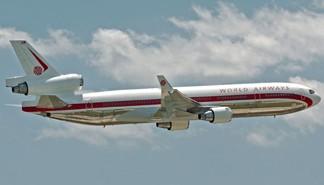Wed, Jul 13, 2011
Says Pilots Should Be Better Trained In High Sink Rate
Awareness, Bounce Recovery
The NTSB on Tuesday sent two recommendations to the FAA
concerning Boeing's MD-11.

File Photo
In the document, the board recommended that the FAA require
Boeing to revise its MD-11 Flight Crew Operating Manual to
reemphasize high sink rate awareness during landing, the importance
of momentarily maintaining landing pitch attitude after touchdown
and using proper pitch attitude and power to cushion excess sink
rate in the flare, and to go around in the event of a bounced
landing.
Once Boeing has completed the revision of its MD-11 Flight Crew
Operating Manual as recommended in Safety Recommendation A-11-68,
require all MD-11 operators to incorporate the Boeing-recommended
bounce recognition and recovery procedure in their operating
manuals and in recurrent simulator training.
The recommendations stem from an accident on July 27, 2010, in
which a Boeing MD-11F equipped with General Electric CF6-80C2
engines, German registration D-ALCQ, operated by Lufthansa Cargo as
flight 8460, caught fire after a hard landing at King Khalid
International Airport, Riyadh, Saudi Arabia (RUH). The airplane
bounced twice, experiencing a strong pitch up after the second hard
touchdown, followed by strong nose-down pitch forces and vertical
loads at the third and final touchdown that caused the fuselage to
rupture. The two pilots, who were the only airplane occupants, were
transported to the hospital with injuries. The airplane was
destroyed. The flight was a scheduled cargo flight from Frankfurt,
Germany, (FRA) to RUH.

According to the recommendation letter, although it is not
uncommon for jet transport aircraft to experience a small skip or
bounce during landing, since it was entered into service in 1990,
the MD-11 has had at least 14 events of such severity that the
aircraft sustained substantial damage, including 4 events that were
complete hull losses. Seven of these events have taken place in the
last 2 years. The number and severity of these events raise
concerns that MD-11 flight crews are not effectively trained to
recognize and arrest high sink rates during landing or to properly
control pitch attitude following a hard landing.
More News
Also: B-29 Superfortress Reunion, FAA Wants Controllers, Spirit Airlines Pulls Back, Gogo Galileo Van's Aircraft posted a short video recapping the goings-on around their reorganiz>[...]
Light Gun A handheld directional light signaling device which emits a brilliant narrow beam of white, green, or red light as selected by the tower controller. The color and type of>[...]
"The journey to this achievement started nearly a decade ago when a freshly commissioned Gentry, driven by a fascination with new technologies and a desire to contribute significan>[...]
"Our driven and innovative team of military and civilian Airmen delivers combat power daily, ensuring our nation is ready today and tomorrow." Source: General Duke Richardson, AFMC>[...]
Aircraft Conflict Predicted conflict, within EDST of two aircraft, or between aircraft and airspace. A Red alert is used for conflicts when the predicted minimum separation is 5 na>[...]
 Airborne 04.16.24: RV Update, Affordable Flying Expo, Diamond Lil
Airborne 04.16.24: RV Update, Affordable Flying Expo, Diamond Lil ANN's Daily Aero-Term (04.20.24): Light Gun
ANN's Daily Aero-Term (04.20.24): Light Gun Aero-News: Quote of the Day (04.20.24)
Aero-News: Quote of the Day (04.20.24) Aero-News: Quote of the Day (04.21.24)
Aero-News: Quote of the Day (04.21.24) ANN's Daily Aero-Term (04.21.24): Aircraft Conflict
ANN's Daily Aero-Term (04.21.24): Aircraft Conflict




